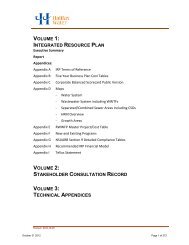Guidelines for the Preparation of Transportation Impact Studies - 8th ...
Guidelines for the Preparation of Transportation Impact Studies - 8th ...
Guidelines for the Preparation of Transportation Impact Studies - 8th ...
You also want an ePaper? Increase the reach of your titles
YUMPU automatically turns print PDFs into web optimized ePapers that Google loves.
3. Prior studies made outside <strong>the</strong> Halifax Regional Municipality <strong>for</strong> a similar land use.<br />
These studies should only be used if <strong>the</strong>y are approved in advance by HRM Traffic and<br />
<strong>Transportation</strong>.<br />
4. Special studies conducted specifically <strong>for</strong> <strong>the</strong> study at hand. Developments surveyed<br />
should be representative <strong>of</strong> <strong>the</strong> development <strong>for</strong> which <strong>the</strong> trip generation estimate is to<br />
be made. These should be local if similar developments exist and can be isolated <strong>for</strong><br />
proper surveys. They may be made out <strong>of</strong> town if no adequate local examples can be<br />
surveyed. Proper procedures should be used. Study sites should be approved in advance<br />
by HRM Traffic and <strong>Transportation</strong>.<br />
5. A combination <strong>of</strong> <strong>the</strong> above, adding local data to <strong>the</strong> I.T.E. data, or combining local or<br />
special study data. Additions to I.T.E. data should be plotted on <strong>the</strong> scatter diagram<br />
provided in <strong>the</strong> latest edition <strong>of</strong> Trip Generation, if available, to check <strong>for</strong> consistency.<br />
Combination <strong>of</strong> data from different sources should be approved in advance by HRM<br />
Traffic and <strong>Transportation</strong>.<br />
Geometric and Traffic Characteristics Input<br />
Geometric Data such as <strong>the</strong> number <strong>of</strong> lanes, lane widths, adjacent parking lanes and grade may<br />
be available from HRM Where not available <strong>the</strong> consultant will have to per<strong>for</strong>m an on-site<br />
survey to determine <strong>the</strong> required in<strong>for</strong>mation. For proposed intersections or modifications to<br />
existing intersections <strong>the</strong> analysis should differentiate what is existing and what is proposed.<br />
Traffic Characteristics - Peak Hour Factors (PHF) should be left at <strong>the</strong> default <strong>of</strong> 0.90 unless<br />
supporting data <strong>for</strong> a change is provided.<br />
Right turn on red (RTOR) should be based on field observation. In <strong>the</strong> absence <strong>of</strong> this data, <strong>the</strong><br />
default <strong>of</strong> zero should be used, unless <strong>the</strong> right turn is shadowed by a turn from ano<strong>the</strong>r direction.<br />
In this case an estimate <strong>of</strong> RTOR may be used.<br />
Saturation Flow Rates <strong>of</strong> 1900 vehicles per hour are <strong>the</strong> standard used in HRM. O<strong>the</strong>r values are<br />
possible, but must be justified.<br />
Heavy Vehicle rates <strong>of</strong> two percent should be used on arterial roadways, unless o<strong>the</strong>rwise<br />
supported by data.<br />
Pedestrian Volumes should be based on counted and projected volumes. For base volumes, in<br />
<strong>the</strong> absence <strong>of</strong> pedestrian volume counts use 100 persons per hour in core areas. 50 persons per<br />
hour in o<strong>the</strong>r city areas, and 10 persons per hour in suburban areas.<br />
Bus stops per hour should be based on Metro Transit bus schedules. Route maps and bus<br />
schedules are available through Metro Transit (902) 490-4000.<br />
TISGUIDE8.WPD September 1, 2007 page B-3
















